2012 VOLKSWAGEN GOLF MK6 remote start
[x] Cancel search: remote startPage 135 of 516

Opening and closing
this section find info rmation about:
R em o
te control vehicle keys . . . . . . . . . . . . . . 37
Mec hanical key . . . . . . . . . . . . . . . . . . . . . . . . . 38
Volkswagen
Power locking and clos ing system 41
Starti ng and stopping the engine
Cons ume r inf ormat ion
Eme rgen cy closin g and opening
Always keep remote control vehicle key fobs with batteries, spare batterie s, as as
dead button mm batteries out of the reach of children.
Get medical attention immediately if you suspect that a battery has been swallowed .
use of vehicle key s can result in se-rious personal injury.
36 Before driving
Always take the key with you when you leave the vehicle . can be used to start the
engine and operate vehicle systems s uch as
the powe r windows, leading to se rious personal injury.
the vehicle is moving or to a stop. The steering wheel lock and you
Page 137 of 516
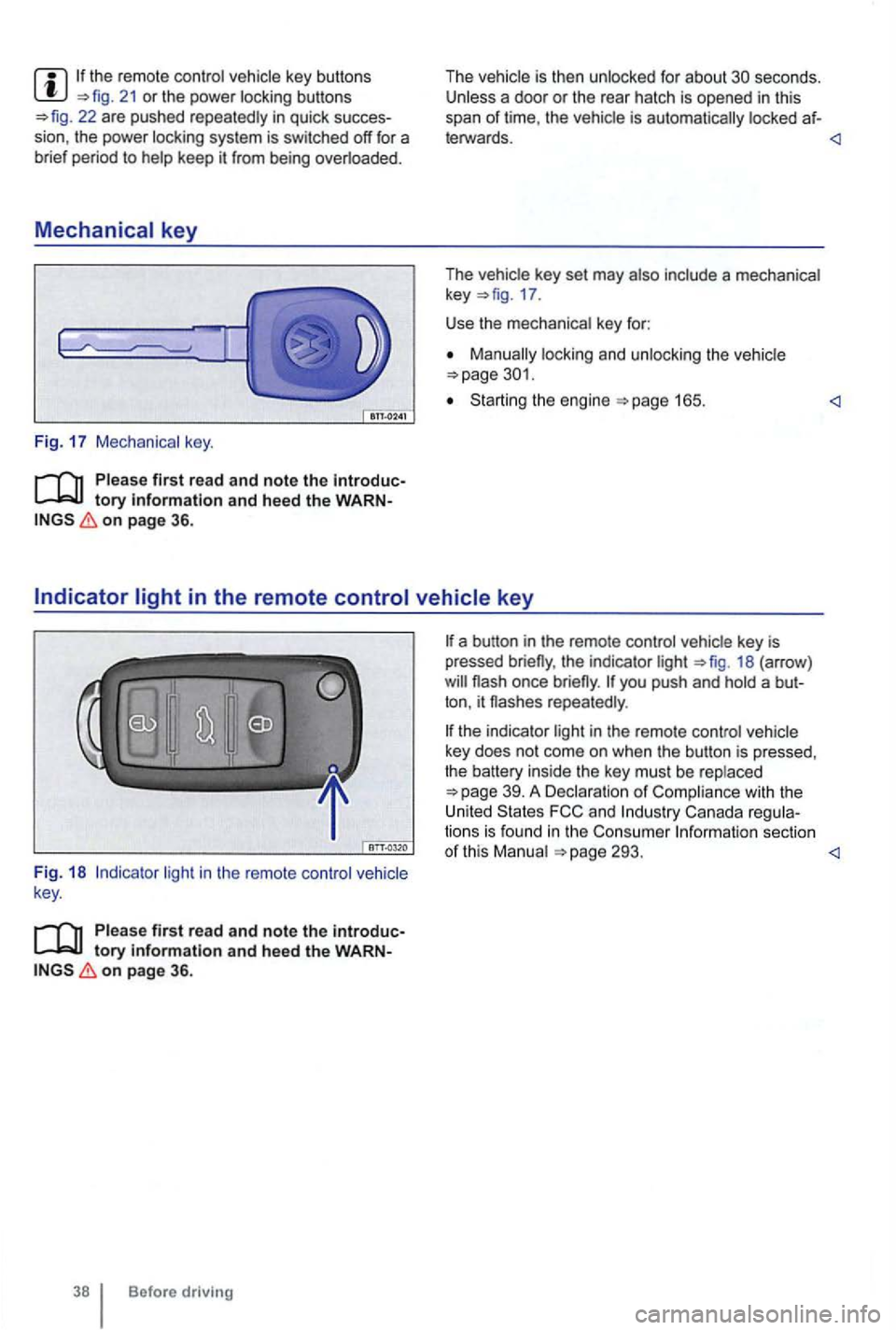
21 or the power locking buttons 22 are pushed repeatedly in quick succes
sion , the power locking system is switched off for a
br i
ef period to help keep it from being overloaded.
Mechanical key
Fig. 17 Mechanical key.
tory information and heed the WARNon page 36.
The vehicle is then unlocked for about secon ds. Unless a door or the rear hatch is opened in this
span of lime , th e vehicle is automatically locked af-
leiWards.
key 17 .
Use the mechanical key for:
locking and unlocking the vehicle
Starting the engine
light in the remote control vehicle
key .
Please first read and note the introductory information and heed the WARNon page 36.
Before driving
the indicator light 18 (arrow )
repeatedly .
the indicator light in the remote control vehicle
key does not come on whe n the button is pressed,
t he battery inside
the key mus t be rep laced
293.
Page 144 of 516
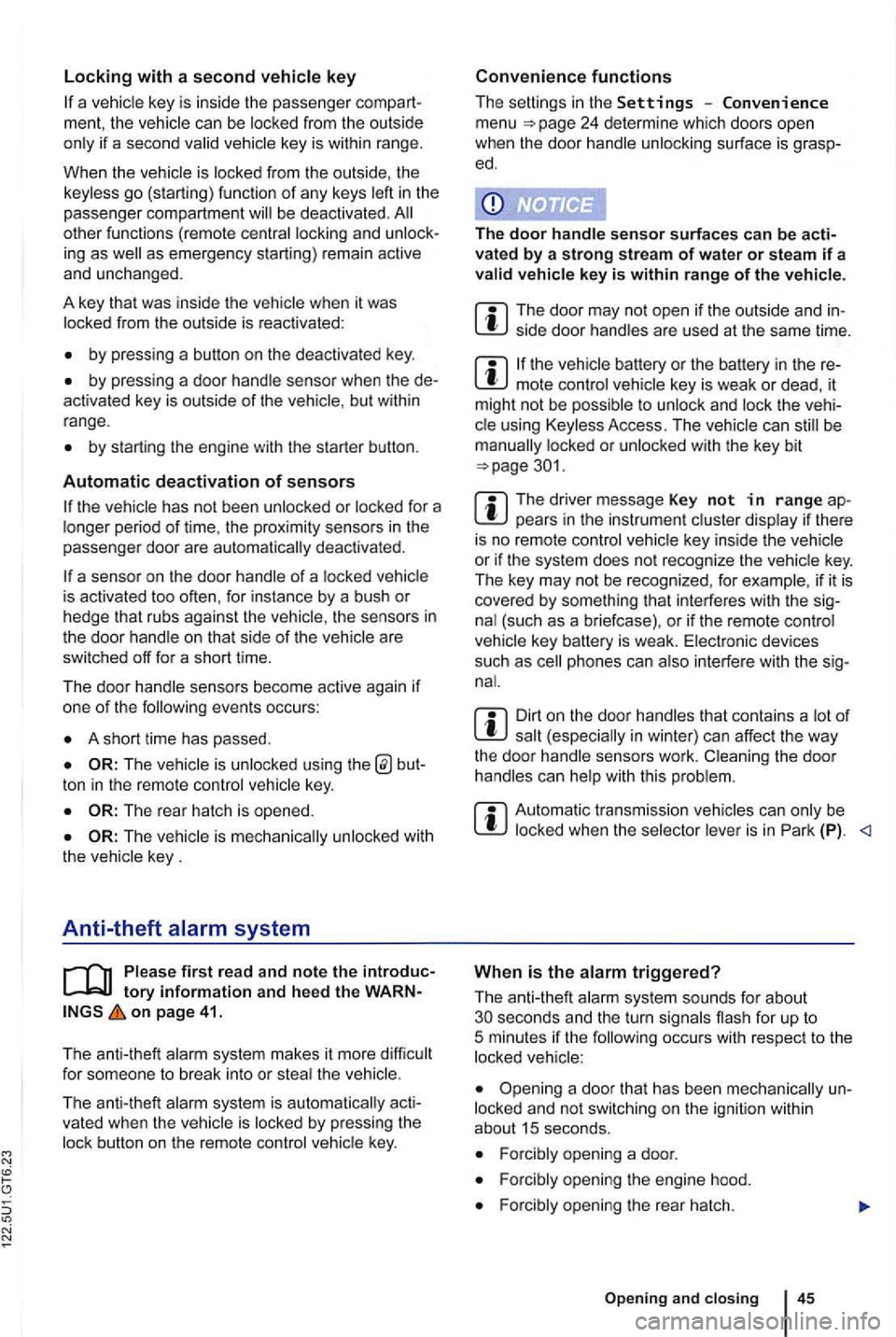
N
if a seco nd valid
by press ing a button on the deactivated key.
by pressing a door handle sensor when the de
activated key is outside of the vehicle , but with in
range .
by starting the engine with the starter butto n.
Automatic deactivation of sensors
deactivated .
is activated too often, for instance by a bush or hedge that rubs against the the sensors in the door handle on that side of the vehicle are
switched off for a short time.
T he door handle sensors become active again if
one of the even ts occurs:
A short time has passed.
The rear hatch is opened .
The key .
Anti-theft
tory information and hee d the WARN on page 41.
T he anti-theft alarm system makes it more difficult
for someon e to break into or steal the veh icle .
The anti-theft alarm system is
key i s within range of the vehicle.
T he door may not open if the outside and in side door handles are used at the same time.
the vehicle battery or the battery in the remote control vehicle key is weak or dead , it
might not be possible to unlock and using Keyless Access. The vehicle can locked or unlocked with the key bit
The driver message Key not in ra nge ap pears in the instrument cluster display if there
is no remote control vehicle key inside the vehicle
or if the system does not recognize the
key. The key may not be recognized , for example, if it is
covered by something that interferes with the sig
(such as a briefcase) , or if the remote control
vehicle key battery is weak. Electronic devices
such
as phones can interfere with the sig
Dirt on the door handles that conta ins a of in winter) can affect the way
the door handle sensors work.
with this problem .
Automatic transmissio n vehic les can
Opening a door that has been un
locked and not switching on the igni tion with in
about 15 seconds.
Forcibly opening a door.
Forcibly opening the engine hood.
Forcib ly opening the rea r hat ch.
and closi ng 45
Page 155 of 516
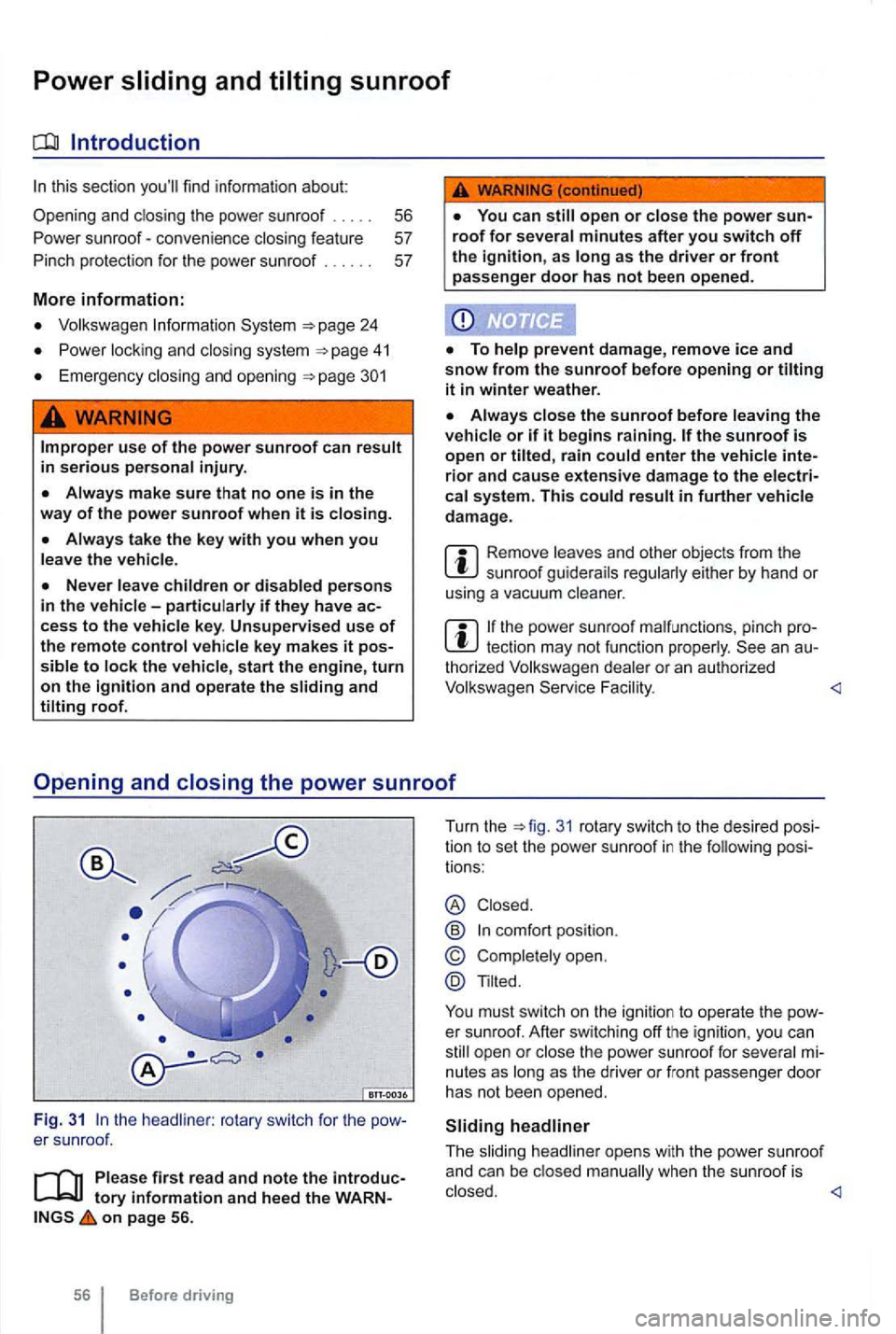
Power
protection for the power sunroof
More information:
Volkswagen 24
locking and closi ng system
Emergency closing and opening
56
57
57
cess to the vehicle key. Unsupervised use of the remote control vehicle key makes it sible to lock the vehicle, start the engine, turn on the ignition and operate the sliding and tilting roof.
Remove leaves and other objects from the sunroof guiderails regularly either by hand or
using a vacuum cleaner.
the powe r sunroof malfunctions, pinch tection may not function properly . an
Opening and
the headliner : rotary switch for the
on page 56.
56 Before driving Turn
the
31 rotary switch to the desi red pos i
tio n to set the power sunroof in the following posi
tions :
® Closed .
@
Tilted.
You must switch on the ignition to operate the
Page 266 of 516
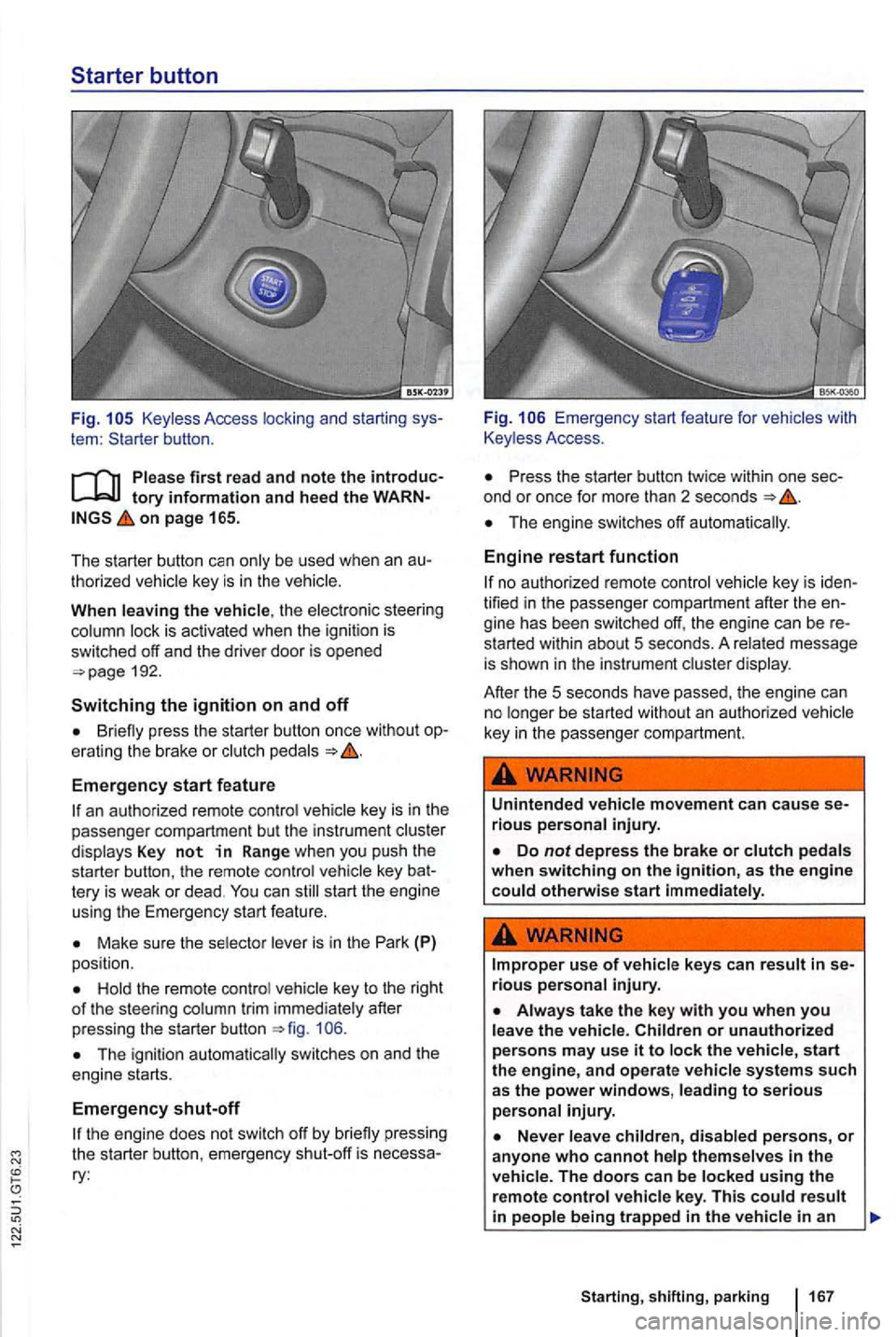
Keyless Access locking and starting sys
tem :
on page 165.
The starter button
be used when an au
t horized
the elec tronic steering is ac tivated when the ignit io n is
swi tched off and the driver door is opened
192.
Switching the ignition on and off
press the starter button once without op
e rating the brake or
Emergency start feature
an authorize d remote veh icle key is in the
passenger compartment but the inst rume nt
can
Make sure the
key to the right of the steering trim immed iate ly after
p ressing the starter button
the
eng ine starts.
Emergency shut-off
the engine does not switch off by
Press the starte r butt on twice within one sec
ond or once for more than 2 secon ds
Engine restart function
no author ize d r emote control veh ic le key is iden
tified in the passenger compartmen t afte r the en
gine has been switched off, the engin e can be re
s tarted wi
thin about 5 seconds . A rela ted message
is sh ow n in the instrument cluster displa y.
Afte r the
5 seconds have passed, the engine can
n o be started without an author ized ve hicle
key in the passenger compartment.
Unintended
in se
rious
start th e engine, and operate vehicle systems such as the power windows,
The doors can be
Starting, shifting, parking 167
Page 322 of 516
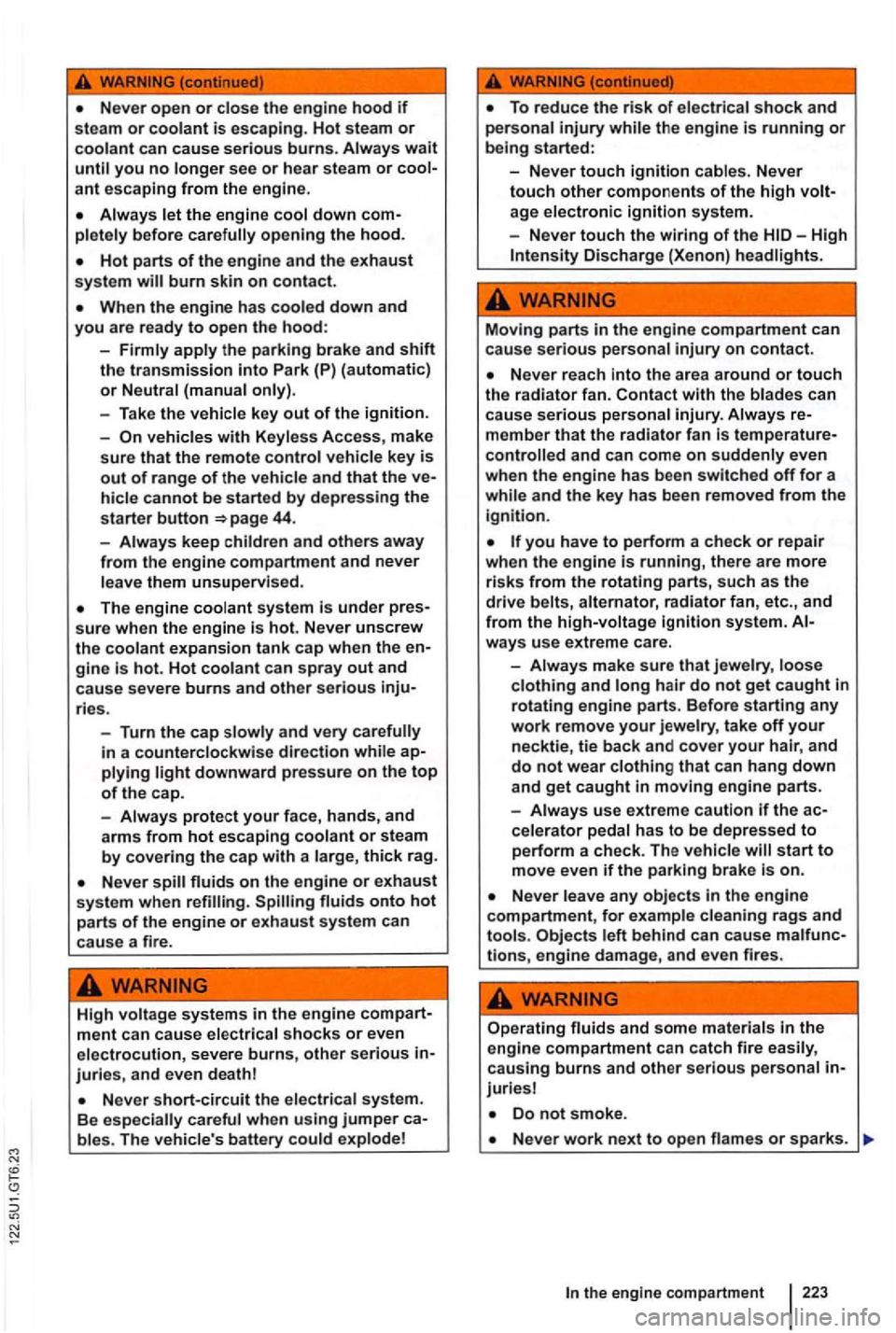
Never open or close the engine hood if To reduce th e risk of electrica l shock and steam or coolant is escaping. Hot steam or personal injury
-Never touch ignition cables. Never ant escaping from the engine. touch other components of the high
Always the eng ine down com-age electronic ignition syste m .
opening the hood.
-Never touch the wiring of the Discharge (Xenon) headlights.
system burn skin on contact.
you are read y to open the hood: Moving parts in th e engine compartment can
- Firm ly apply the parking brake a nd shift cause serious personal injury on contact. the transmission into Park (P) (automatic)
vehicles with Keyless Access, make member that the radiator fan is temperature-
s
ure that the remote contro l vehicle key is controlled and can come on sudden ly even
out of range of th e vehicle and that the ve- when the engine
has been switched off for a
hicl e cannot be started by depres sing the 44. ignition.
-
Always keep children and others away you have to perform a check or repair from the engine compartment and never when the engine is runn ing, there are more leave them unsupervised. risks from the rotating parts, such as the
hair do not get caught in
ries. rotating engine
parts. B efore starting an y
- Turn
the cap
fluids onto hot parts of the engine o r exhaust system can
cause a fire. -
Always use
extreme caution if the ac-
ce lerato r pedal has to be depressed to perform a check. The vehicle will start to move even if the parking brake i s on.
Never leave any objects in the engine compartment, for examp le cleaning rags and tools. Objects left b ehind can cause malfunc-lions, engine damage, and even fires.
High voltage sy stems in the engine com part-ment can ca use electrica l shocks or even
electrocution, severe burns, other serious in-juries, and eve n deathl
Neve r short-circuit the electrica l syste m .
B e especially ca reful when using jumper ca-
Operating fluids and some materials in the engi ne compartment can catch fire easily, causing burns an d other serious personal in-juries
Do not smoke .
b les. The
vehicle 's battery could exp lode! Never work next to open flames or sparks .
223
Page 335 of 516
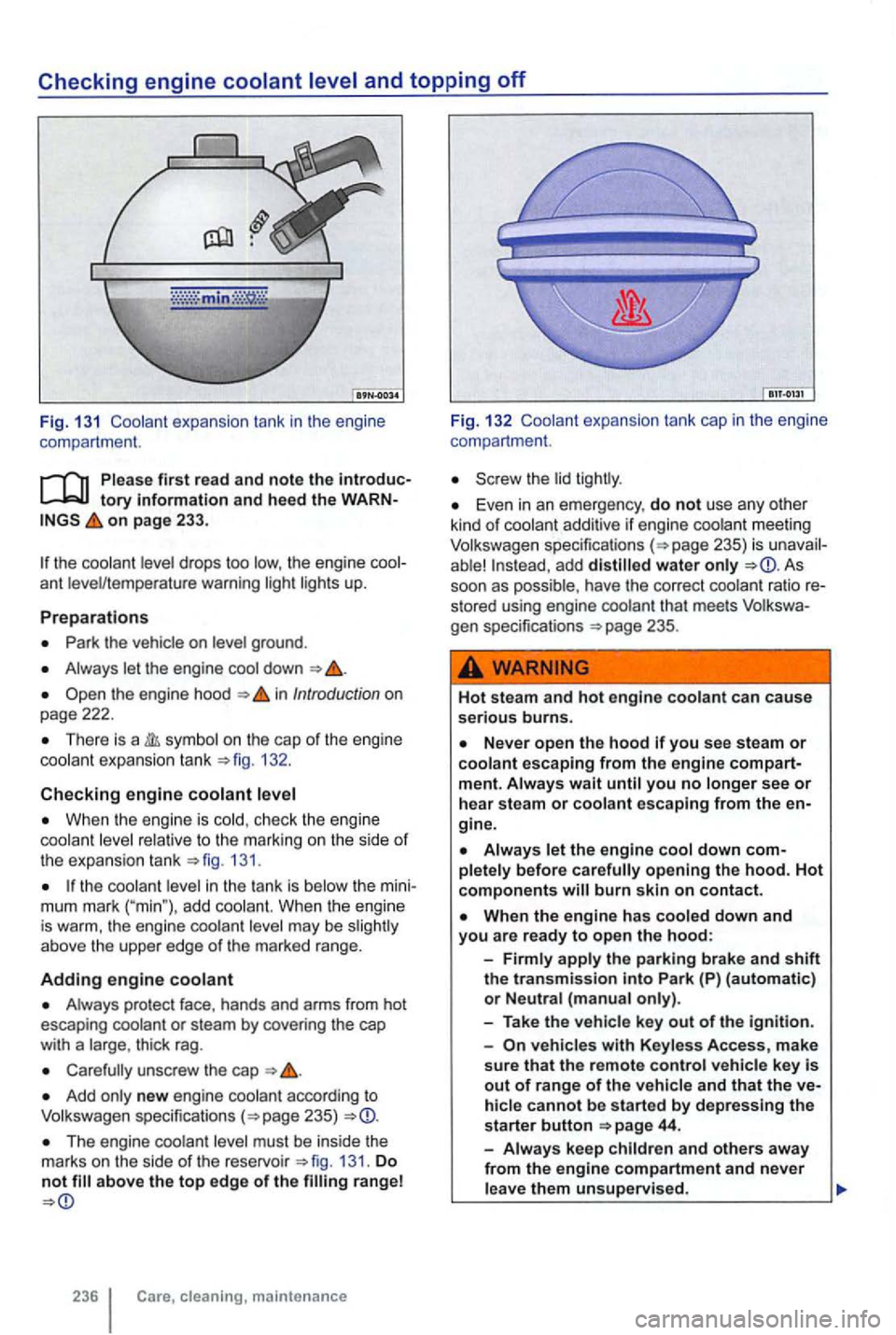
Checking engine coolant level and topping off
Fig. 13 1 Coolant expan sion tank in the engi ne
compartme nt.
Please first read and note the introductory Information and heed the WARN on page 233.
Park the vehicle on level ground .
Always let the engine down
the engine hood in Introduction on
page 222.
There is a sy mbol on the cap of the engine coolant expans ion tank 132 .
Checking engine coolant
When the engine is cold , check the engine
coolant level relative to the marking on the side of the expansion tank 13 1.
the coolant level in the tank is below the mini
mum mark ("min"), add coolant. When th e engi ne is warm, the engine coolant level may be slig htly
above the upper edge of the marked range.
Adding engine coolant
Always protect face, hands and arms from hot
escaping coolant or steam by covering the cap
with a large , thick rag.
Carefully unscrew the cap
Add only new engine coolant according to
The engine coolant level must be inside the
marks on the side of the reservoir 131. Do not
236 cleaning, maintenance Fig.
132 Coola nt expansion tank cap in the eng ine
compa rtment.
Screw the lid tightly .
Even in an emergency , do not use any other kind of coolant additive if engine coolant meeting
add distilled water only As
soon as possible , have the correct coolant ratio re
sto red using engine coolant that meet s
WARNING
Hot steam and hot engine coolant can cau se serious burns.
Neve r open the hood you see steam or coolant escaping from the engine compartment. Always w ai t until you no longer see or hea r steam or co olant escaping from the en
gine .
opening the hood. Hot components will burn skin on contact.
Park (P) (automatic) or Neutral (manua l only).
- Take the vehicle key
out of the ignition.
-
veh icles with Keyless Access, make
sure that the remote control vehicle key is out of range of the vehicle and that the vehicle cannot be sta rted by depressing the
starte r button 44.
-
Always keep children and others away
from the engine compartment and never
l eave them unsupervised.